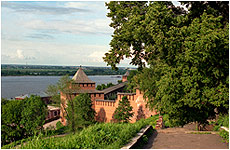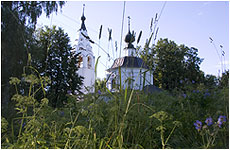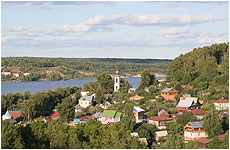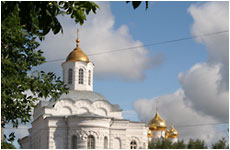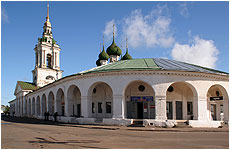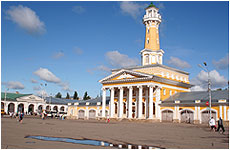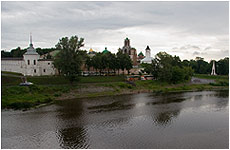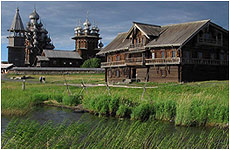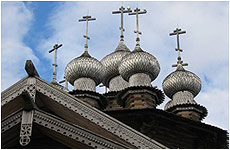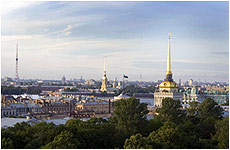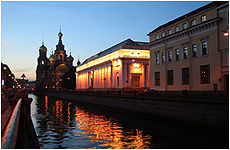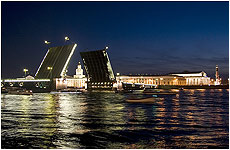 |
 |
||||||||||||||||||||||||||||||||||||
|
CONFERENCE VENUE The Conference will be held on board of a comfortable 4-deck boat cruising from Nizhny Novgorod to St. Petersburg along the river Volga and lake Ladoga, through ancient cities and historical places of Gorodets, Plyos, Kostroma, Yaroslavl, Kizhi, and Valaam. This route will give the participants a unique occasion to get familiar with both Russian history and nature.
Nizhny Novgorod is a wonderful ancient center of the Volga region. It was founded at the beginning of the XIII century at the confluence of two big rivers: the Volga and the Oka. A sign of an ancient city of Russia is the kremlin on the high bank of the Volga. There are many unique historical, architectural and cultural monuments preserved in Nizhny Novgorod and its vicinities, for example, the famous Makariev Monastery. UNESCO included the city into the list of 100 world cities, which are of a historical and cultural value.
Gorodets was founded in 1152. Prince Aleksandr Nevsky died here, on his way back to Novgorod from the Golden Horde. In 1238 the town was burnt by the army of Batu Khan, and in 1408, by the emir of the Golden Horde, Edigu. One can still see here the ancient city mound and provincial houses of the 19th century, but the main glory of the city is not the relics, but the handicrafts. Houses in Gorodets are decorated with astonishingly beautiful wood carvings. Gorodets is also famous for its cakes baking traditions and as a home of a decorative painting style with floral ornaments. Not far from Gorodets is Khokhloma, the home of another world-known «golden» wood painting art. Plyos, this admirable «Pearl of the Volga», is about six hundred years old. For a long time it served as a citadel beating off enemy attacks. Later it turned into a trading centre. The town is situated in a very nice place, the view from the hill tops around the town is one of the most beautiful on the whole Volga, and attracted here many artists and tourists from all over Russia.
Kostroma was first mentioned in the chronicles in 1213. In 1773, Kostroma was devastated by a great fire. Afterwards the city was rebuilt with streets radiating from a single focal point near the river. One of the best preserved examples of the 18th century town planning, Kostroma retains some elegant structures built in the style that may be called «provincial classicism».
Yaroslavl was founded in the 11th century by Prince Yaroslav I the Wise at the junction of the Volga and the Kotorosl. Its main landmarks are amazingly beautiful cathedrals built in the 17th century, the remains of the golden age of Yaroslavl, when skilful architects and painters worked here. The murals of the Church of Elijah the Prophet in the main square of the city is a unique museum of ancient Russian painting. The Church of St. Nicholas «Nadein» with its carved and gilt baroque iconostasis and the unique Church of St. John the Baptist with its fifteen domes are masterpieces of the heart-warming and magnificent architectural school of Yaroslavl. This year the city will celebrate its millennium.
Kirillo-Belozersky Monastery in the town of Kirillov on Lake Siverskoye was founded by Kirill Belozersky at the end of the 14th century. The icons in the Assumption Cathedral date back to the 15th century, and the murals in the cathedral telling the story of the Virgin Mary's life, to the 17th century. The Apocalypse murals in the porch that were painted at the same time are not less interesting. The magnificent ensemble of the monastery comprises the Churches of Baptism of Our Saviour, of John the Baptist, and of the Archangel, farmeries, fortress walls with high bartizans and two over-the-gate churches. The local museum has collections of manuscripts, ancient utensils, samples of wooden carving and traditional embroideries. Kizhi, is an island on Lake Onega with a beautiful ensemble of wooden churches, chapels and houses. Some of these buildings were originally constructed in Kizhi, some (the minor ones) were transported there to create a museum of Russian wooden architecture. The twenty-two-headed Transfiguration Cathedral (1714) and the Church of Resurrection of Lazarus are world-famous.
Valaam Archipelago is staggeringly beautiful due to the fantastic maze of its coves, lakes, and rocks. The ancient Valaam Monastery is situated here; it was first mentioned in chronicles in the 10th century. For many years the Monastery was a religious and cultural center of Russia supported by Russian Tzars and the Russian Orthodox Church. The Monastery was completely self-sufficient and monks produced all the necessary products themselves while working at small factories, saw-mills and farms, constructing buildings. At the beginning of the 20th century the Valaam Monastery became one of the wealthiest Russian Monasteries, comprising a kind of a small state with 13 smaller monasteries under control. During the Second World War the Archipelago was under control of Finland and returned back to the USSR in 1944. Since that time the Monastery was closed until 1989. Now it is functioning again. The monastery, hermitage huts, and chapels built in the Russian-Byzantine style are architectural masterpieces. The ensemble created by these buildings matching the stern nature of the islands, by the monastery gardens and alleys is inimitably beautiful. Saint Petersburgis one of the most beautiful cities in Europe. The majestic appearance of St. Petersburg is created by a variety of architectural details including long, straight boulevards, vast spaces, gardens and parks, decorative wrought-iron fences, monumental and decorative sculptures. The Neva River itself, together with its many canals and their granite embankments and bridges, gives the city a unique and striking ambience. Undoubtedly the most famous of St. Petersburg museums (of which there are plenty) are the Hermitage and the Russian Museum. St. Petersburg has been known as the city of palaces. One of the earliest of these is the Summer Palace, a modest house built for Peter I in the Summer Garden (1710-1714). Much more imposing are the baroque residences of his associates, such as the Menshikov Palace on the Neva Embankment designed by Domenico Trezini in 1710-1716. A residence adjacent to the Menshikov palace was redesigned for Peter II and now houses the state university. Probably the most illustrious of imperial palaces is the baroque Winter Palace (1754-1762), a huge building with dazzlingly luxurious interiors, now housing the Hermitage Museum. The largest church in the city is St Isaac Cathedral (1818-1858), one of the biggest domed buildings in the world, constructed for 40 years under supervision of its architect, Auguste de Montferrand. Another magnificent church in the Empire style is the Kazan Cathedral (1801-1811), situated on the Nevsky prospect and modeled after St. Peters’s Cathedral in Vatican. No tourist can miss the Church of the Savior on Blood (1883-1907), a gorgeous monument in the old Russian style which marks the spot of Alexander II‘s assassination. As Tzar Peter the Great forbade building onion spires, this church is exceptional in the city with its onion-shaped tower. St Petersburg is surrounded with imperial residences: Peterhof, with the Grand Peterhof Palace and glorious fountain cascades; Tsarskoe Selo (now Pushkin), with the baroque Catherine Palace and the neoclassical Alexander Palace; and Pavlovsk, which contains a domed palace of Emperor Paul and one of the largest English-style parks in Europe.
The social program offered to the participants and accompanying persons will include sightseeing and tours of the cities and historical places along the cruise route, and a set of social events including music concerts aboard and conference parties.
|
|||||||||||||||||||||||||||||||||||||


